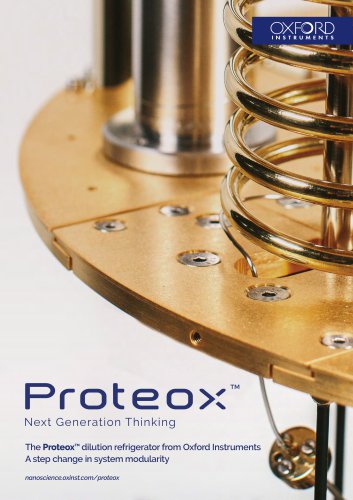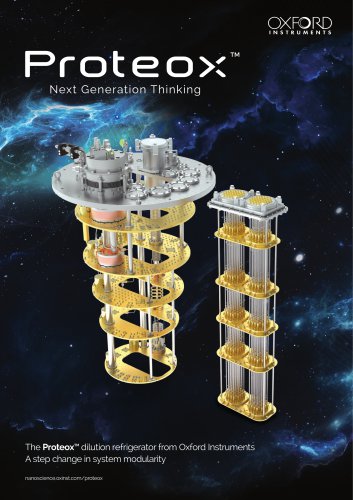
Catalog excerpts
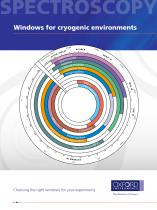
SPECTROSCOPY Windows for cryogenic environments 2 5,00 -1 lB trosi pec rosil WF S ct Spe hire p Sap um Flouride ci Cal talline Quartz s Cry propylene Poly .3 Choosing the right windows for your experiments
Open the catalog to page 1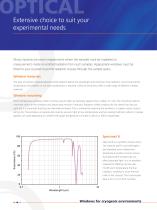
Extensive choice to suit your experimental needs Many cryostats are used in experiments where the samples must be irradiated or measurements made on emitted radiation from such samples. Appropriate windows must be fitted to your cryostat to permit radiation to pass through the sample space. Window materials The type of window material selected will be determined by the wavelength and intensity of the radiation, the environmental temperature and whether or not beam polarisation is required. Oxford Instruments offers a wide range of different window materials. Window mounting Room temperature...
Open the catalog to page 2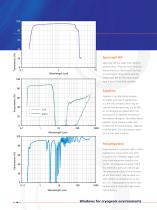
Spectrosil WF is a water free synthetic vitreous silica. It has the same material a transmission range which extends further into the IR. The transmission data is for a 2 mm thick window. Sapphire Sapphire is an alternative window for visible and near IR applications. It is the only window which may be used at high temperatures (up to 500 transmission of sapphire increases in the extreme IR region. This effect allows sapphire to be used as a cold inner window for IR measurements. Sapphire is birefringent. The transmission data is for a 2 mm thick window. Polypropylene is a polymer with a...
Open the catalog to page 3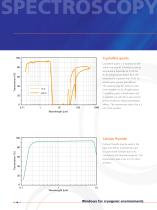
SPECTROSCOPY Crystalline quartz Crystalline quartz is a window for the visible and near IR. It exhibits a strong temperature dependence in the far IR. At temperatures below 80 K the transmission is greater than 70% for wavelengths greater than 80 μm. This material may be used as a cold inner window for far IR applications. Crystalline quartz is birefringent and is available cut with the z-axis normal to the window to reduce polarisation effects. The transmission data is for a 2 Calcium fluoride Calcium fluoride may be used in the near and mid IR. It cannot be used as a cold inner window due...
Open the catalog to page 4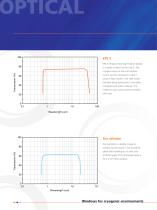
KRS 5 KRS 5 (Thallium Bromide-Thallium Iodide) complex nature of the cold window mount and the necessity to make it vacuum tight results in the clear access diameter being reduced by 2 mm when compared with other materials. The material is toxic and should be handled with care. Zinc selenide Zinc selenide is a reliable cryogenic window for the mid IR. Care should be taken with handling as it is toxic and scratches easily. The transmission data is Windows for cryogenic environments
Open the catalog to page 5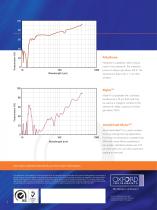
Polythene is a polymer which may be used in the extreme IR. The material is porous to helium gas above 100 K. The transmission data is for a 1 mm thick window. MylarTM Mylar™ is a polyester film. Standard windows are 125 μm thick and may be used as a cryogenic window in the extreme IR. Mylar is porous to helium Aluminised MylarTM Aluminised Mylar™ is a useful window for X-ray and gamma ray applications. For X-rays its transmission is greater than 90% with some diffuse scattering at low angles. Standard windows are 125 μm thick with a 0.3 μm thick aluminium coating on one side. visit...
Open the catalog to page 6All Oxford Instruments NanoScience catalogs and technical brochures
-
MercuryiTC & iPS
2 Pages
-
ProteoxS
4 Pages
-
ProteoxTM5mK
3 Pages
-
KelvinoxTLM®
2 Pages
-
KelvinoxJT®
2 Pages
-
2022 SpectromagPT
4 Pages
-
The Kelvinox Family ®
10 Pages
-
HelioxVL™
2 Pages
-
Proteox 2021
18 Pages
-
Teslatron™PT
2 Pages
-
SampleProtect
2 Pages
-
Optistat™Dry
2 Pages
-
OmniProbe 100
5 Pages
-
INCAGSR
8 Pages
-
Mercury Instrumentation
4 Pages
-
Nanonis Tramea™
16 Pages
-
Heliox
4 Pages
-
kelvinox - product brochure
8 Pages
-
kelvinox
2 Pages
-
Triton
4 Pages
Archived catalogs
-
Proteox 2020
5 Pages
-
Microstat
8 Pages
-
MercuryiTC
6 Pages
-
2011 SpectromagPT
4 Pages











